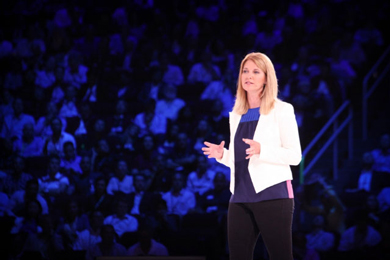WPC: MPN To Add Design Competency
- Stay up-to-date on the latest news from WPC here.
In yet another sign of Microsoft's newfound commitment to aesthetics, the Microsoft Partner Network (MPN) will add a competency in User Experience Design in January.
MPN competencies are badges that partners can earn to demonstrate their expertise in a given practice area. Microsoft currently has 25 competencies, each with either a silver or gold level. Achieving a competency requires a partner to employ professionals with relevant certifications, pay a joining fee, complete other training and, in some cases, make revenue commitments.
Tami Reller, Microsoft's chief marketing officer and chief financial officer for Windows, announced the User Experience Design competency during her keynote Monday at the Microsoft Worldwide Partner Conference in Houston.
 Microsoft's Tami Reller speaking at Monday's WPC keynote. (Source: Microsoft)
Microsoft's Tami Reller speaking at Monday's WPC keynote. (Source: Microsoft)
"Apps that are better designed, they absolutely achieve better ratings in the Windows Store, and even equally as important, they are more engaging for customers, and they deliver greater monetization opportunities," Reller said. "The whole idea behind this competency is to give you the best way to train your designers and to get recognized for your expertise with the Microsoft design language and user experience for app building."
Microsoft first began gaining notice for its design work with the Windows Phone launch several years ago, and many of the design principles behind the Windows Phone UI and that platform's apps influenced the design of Windows 8.
In a blog posting about the new competency, Orlando O'Neill, product marketing manager for Windows Apps, reinforced Microsoft's current attitude toward design.
"In the past few years, we've focused on improving the user experience and design of our platforms, making them more intuitive, familiar and enjoyable to engage with. Our point of view is embodied in the Microsoft design language: we sweat the details of every pixel, we let the OS fade into the background while your ideas and content come to the fore, and we believe in presenting content and controls in a way that is authentically digital," O'Neill wrote. "We firmly believe that user experience and design are going to be the next big differentiators for Microsoft and, more importantly, for the apps and experiences that you build for your customers."
While Reller didn't say so, Microsoft has been increasingly steering incentive money through Gold Competency partners in recent years, and Microsoft's ongoing efforts to expand the number of Windows Store apps are likely to mean more MDF funds and other incentives for partners with the competency than those without.
More News and Analysis from WPC 2013:
Posted by Scott Bekker on July 09, 2013